Predicting the Potential Distribution of Galeruca daurica in Inner Mongolia Under Current and Future Climate Scenarios Using the MaxEnt Model
Simple Summary
Abstract
1. Introduction
2. Materials and Methods
2.1. Species Occurrence Data and Preprocessing
2.2. Environmental Variables
- 19 bioclimatic variables (current and future) from the WorldClim database (https://www.worldclim.org/; accessed on 1 April 2024) under three Shared Socioeconomic Pathways (SSP1-2.6, SSP2-4.5, SSP5-8.5) for the mid-century (2041–2060) and late-century (2061–2080) periods;
- 3 topographic variables (elevation, slope, and aspect);
- 14 soil variables obtained from the Harmonized World Soil Database (HWSD).
2.3. Model Construction and Evaluation
2.4. Habitat Suitability Classification
- Non-suitable (p < 0.1);
- Low suitability (0.1 ≤ p ≤ 0.27);
- Medium suitability (0.27 < p ≤ 0.48);
- High suitability (p > 0.48).
3. Results
3.1. Model Performance
3.2. Key Environmental Drivers
- Precipitation of the wettest month (bio13)—39.6% contribution;
- Annual precipitation (bio12)—24.0%;
- Annual temperature range (bio7)—8.2%.
3.3. Response Curve Analysis
- Precipitation of the wettest month: 51–82 mm, with maximum presence probability (0.66) at 62 mm.
- Annual precipitation: 180–300 mm, optimal at 240 mm.
- Annual temperature range: 48.5–54.7 °C, optimal at 52 °C.
3.4. Current Potential Distribution
- High suitability: 117,500 km2 (9.9%);
- Moderate suitability: 149,200 km2 (12.6%);
- Low suitability: 264,600 km2 (22.4%).
3.5. Future Habitat Shifts
- SSP1-2.6: Slight short-term expansion in the 2050s (835,100 km2), followed by a decrease by the 2070s (782,300 km2).
- SSP2-4.5: Steady contraction to 486,300 km2 by 2070s (23.56% of Inner Mongolia).
- SSP5-8.5: An initial decline followed by moderate rebound (801,000 km2 in the 2070s).
3.6. Centroid Migration
4. Discussion
5. Conclusions
Supplementary Materials
Author Contributions
Funding
Institutional Review Board Statement
Informed Consent Statement
Data Availability Statement
Conflicts of Interest
References
- Buhe; Wulantuya; Siqinchaogetu; Han, S.M.; Suriguga, G.; Wu, X.Q. Response of vegetation coverage change to meteorological drought in Inner Mongolia from 1982 to 2099. J. Northwest For. Univ. 2023, 38, 1–9. [Google Scholar]
- Chen, X.L.; Yan, Z.Y.; Liu, Q.M.; Li, R.P.; Zhang, S.W. Spatial-temporal characteristics of drought in Inner Mongolia based on optimal remote sensing drought indices selected by GEE. Arid. Land Geogr. 2025, 1–12. [Google Scholar]
- Zhao, S.X.; Zhou, Q.C.; Wang, W.J.; Wu, Y.J. Dry and wet climatic characteristics in Inner Mongolia based on the SPI index. J. China Inst. Water Resour. Hydropower Res. 2022, 20, 10–19. [Google Scholar]
- Guo, X.M.; Tong, S.Q.; Bao, Y.H.; Ren, J.Y. Analysis of drought spatiotemporal variation trends in Inner Mongolia over the past 55 years based on SPEI. Geomat. World 2021, 28, 42–48+79. [Google Scholar]
- Li, H.Y.; Ma, L.; Liu, T.X.; Liang, L.T. Drought spatiotemporal variation characteristics in Inner Mongolia based on standardized precipitation index. J. Hydrol. 2018, 38, 47–51+90. [Google Scholar]
- Hao, X.; Zhou, X.R.; Pang, B.P.; Zhang, Z.R.; Bao, X. Morphological characteristics and biological traits of Galeruca daurica. Acta Agrestia Sin. 2015, 23, 1106–1108. [Google Scholar]
- Yang, X.K.; Huang, D.C.; Ge, S.Q.; Bai, M.; Zhang, R.Z. Outbreak of Galeruca daurica on millions of acres of grassland in Inner Mongolia. Chin. Bull. Entomol. 2010, 47, 812. [Google Scholar]
- Hao, X. Study on the Life History and Occurrence Pattern of Galeruca daurica. Master’s Thesis, Inner Mongolia Agricultural University, Hohhot, China, 2014. [Google Scholar]
- Booth, T.H.; Nix, H.A.; Busby, J.R.; Hutchinson, M.F. Bioclim: The first species distribution modelling package, its early applications and relevance to most current MAXENT studies. Divers. Distrib. 2014, 20, 1–9. [Google Scholar] [CrossRef]
- Denan, N.; Zaki, W.M.W.; Norhisham, A.R.; Sanusi, R.; Nasir, D.M.; Nobilly, F.; Ashton-Butt, A.; Lechner, A.M.; Azhar, B. Predation of potential insect pests in oil palm plantations, rubber tree plantations, and fruit orchards. Ecol. Evol. 2020, 10, 654–661. [Google Scholar] [CrossRef] [PubMed]
- Guisan, A.; Thuiller, W. Predicting species distribution: Offering more than simple habitat models. Ecol. Lett. 2005, 8, 993–1009. [Google Scholar] [CrossRef]
- Lux, J.; Xie, Z.; Sun, X.; Wu, D.; Scheu, S. Changes in microbial community structure and functioning with elevation are linked to local soil characteristics as well as climatic variables. Ecol. Evol. 2022, 12, e9632, Erratum in Ecol. Evol. 2024, 14, e11359. [Google Scholar] [CrossRef]
- Pauli, H.; Gottfried, M.; Dullinger, S.; Abdaladze, O.; Akhalkatsi, M.; Alonso, J.L.B.; Coldea, G.; Dick, J.; Erschbamer, B.; Calzado, R.F.; et al. Recent Plant Diversity Changes on Europe’s Mountain Summits. Science 2012, 336, 353–355. [Google Scholar] [CrossRef]
- Chen, I.C.; Hill, J.K.; Ohlemüller, R.; Roy, D.B.; Thomas, C.D. Rapid Range Shifts of Species Associated with High Levels of Climate Warming. Science 2011, 333, 1024–1026. [Google Scholar] [CrossRef]
- Kumar, P. Assessment of impact of climate change on Rhododendrons in Sikkim Himalayas using Maxent modelling: Limitations and challenges. Biodivers. Conserv. 2012, 21, 1251–1266. [Google Scholar] [CrossRef]
- Hill, M.P.; Gallardo, B.; Terblanche, J.S. A global assessment of climatic niche shifts and human influence in insect invasions. Glob. Ecol. Biogeogr. 2017, 26, 679–689. [Google Scholar] [CrossRef]
- Wang, Z.L.; Xu, D.P.; Liao, W.K.; Xu, Y.; Zhuo, Z.H. Predicting the Current and Future Distributions of Frankliniella occidentalis (Pergande) Based on the MaxEnt Species Distribution Model. Insects 2023, 14, 458. [Google Scholar] [CrossRef]
- Elango, A.; Raju, H.K.; Shriram, A.N.; Kumar, A.; Rahi, M. Predicting ixodid tick distribution in Tamil Nadu domestic mammals using ensemble species distribution models. Ecol. Process. 2025, 14, 13. [Google Scholar] [CrossRef]
- Harte, J.; Umemura, K.; Brush, M. DynaMETE: A hybrid MaxEnt-plus-mechanism theory of dynamic macroecology. Ecol. Lett. 2021, 24, 935–949. [Google Scholar] [CrossRef]
- Elith, J.; Graham, C.H.; Anderson, R.P.; Dudík, M.; Ferrier, S.; Guisan, A.; Hijmans, R.J.; Huettmann, F.; Leathwick, J.R.; Lehmann, A.; et al. Novel methods improve prediction of species’ distributions from occurrence data. Ecography 2006, 29, 129–151. [Google Scholar] [CrossRef]
- Phillips, S.J.; Anderson, R.P.; Schapire, R.E. Maximum entropy modeling of species geographic distributions. Ecol. Model. 2006, 190, 231–259. [Google Scholar] [CrossRef]
- Zhang, J.Y.; Wang, Q.; Gao, H.J.; Qi, Q.L.; He, W.J.; Li, J.Y.; Yao, S.X.; Li, W. Ecological suitability distribution of hop based on MaxEnt modeling. Environ. Monit. Assess. 2025, 197, 346. [Google Scholar] [CrossRef] [PubMed]
- He, Z.P.; Ali, H.; Wu, J.H.; Liu, Z.Q.; Wei, X.J.; Zhuo, Z.H. Impact of climate change on the distribution of Isaria cicadae Miquel in China: Predictions based on the MaxEnt model. Front. Microbiol. 2025, 16, 1509882. [Google Scholar] [CrossRef]
- Kilak, S.H.; Alavi, S.J.; Esmailzadeh, O. Spatial resolution matters: Unveiling the role of environmental predictors in English yew (Taxus bacata L.) distribution using MaxEnt modeling. Earth Sci. Inform. 2025, 18, 214. [Google Scholar] [CrossRef]
- Geest, K.V.; Burkett, M.; Fitzpatrick, J.; Stege, M.; Wheeler, B. Marshallese Migration: The Role of Climate Change and Ecosystem Services: Summary for Policymakers. 2019. Available online: https://rmi-migration.com/ (accessed on 12 June 2025).
- Fabritius, H.; Jokinen, A.; Cabeza, M. Metapopulation perspective to institutional fit: Maintenance of dynamic habitat networks. Ecol. Soc. 2017, 22, 30. [Google Scholar] [CrossRef]
- Wang, E.; Lu, Z.R.; Rohani, E.R.; Ou, J.M.; Tong, X.H.; Han, R.C. Current and future distribution of Forsythia suspensa in China under climate change adopting the MaxEnt model. Front. Plant Sci. 2024, 15, 1394799. [Google Scholar] [CrossRef]
- Zhu, L.H.; Chen, G.Y.; Li, H.; Zheng, R.Q. Habitat suitability assessment of Andrias davidianus in Zhejiang Province using Maxent model. Life Sci. Res. 2025, 1–12. [Google Scholar] [CrossRef]
- Dou, Q.H.; Chen, C.H.; Zengtai, Y.; Longzhu, D.; Miao, Q.; Sun, F.H.; Cairang, L.; Chen, X.; Suonan, J. Predicting habitat suitability of important medicinal plants from Gentianaceae on the Tibetan Plateau using an optimized MaxEnt model. Acta Agrestia Sin. 2025, 33, 3024–3033. [Google Scholar]
- Yan, Z.S.; Shao, M.Q.; Wang, J.Y. Prediction of suitable wintering habitats and key factors influencing the population distribution of Common Crane in China. Chin. J. Appl. Ecol. 2025, 36, 578–586. [Google Scholar]
- Rahaman, M.H.; Masroor, M.; Sajjad, H.; Saha, T.K. Assessment of Habitat Suitability and Potential Corridors for Bengal Tiger (Panthera tigris tigris) in Valmiki Tiger Reserve, India, Using MaxEnt Model and Least-Cost Modeling Approach. Environ. Model. Assess. 2024, 29, 405–422. [Google Scholar] [CrossRef]
- Hou, J.L.; Xiang, J.G.; Li, D.L.; Liu, X.H. Prediction of Potential Suitable Distribution Areas of Quasipaa spinosa in China Based on MaxEnt Optimization Model. Biology 2023, 12, 366. [Google Scholar] [CrossRef]
- Liao, J.F.; Yi, Z.L.; Li, S.C.; Xiao, L. Potential distribution of Miscanthus biformus in different periods based on MaxEnt model. Acta Ecol. Sin. 2020, 40, 8297–8305. [Google Scholar]
- Wang, Y.S.; Xie, B.Y.; Wan, F.H.; Xiao, Q.M.; Dai, L.Y. Application of ROC curve analysis in evaluating distribution models of invasive species. Biodivers. Sci. 2007, 15, 365–372. [Google Scholar]
- Zhao, J.L.; Lancuo, Z.; Wang, W.; Wang, H.D.; Wang, W.; Shen, J.P. Response of suitable habitat areas for highland barley (Hordeum vulgare var. coeleste) on the Tibetan Plateau to climate change based on MaxEnt model. Chin. J. Eco-Agric. 2024, 32, 1626–1638. [Google Scholar]
- Liao, J.; Li, Y.Y.; Zhang, S.Y.; Yang, Y.F.; Xiong, C.H.; Xiao, S.J.; Wang, X.F.; Wang, Z.D.; Guo, Y.S. Potential habitat assessment and niche characteristics analysis of Tachypleus tridentatus and Carcinoscorpius rotundicauda in China based on MaxEnt model. Oceanol. Et Limnol. Sin. 2025, 56, 175–185. [Google Scholar]
- Pan, F.; Chen, M.C.; Xiao, T.B.; Ji, X.C.; Xie, S.H. Research progress on the effects of variable temperatures on insect growth, development and reproduction. J. Environ. Entomol. 2014, 36, 240–246. [Google Scholar]
- Chang, X.N.; Gao, H.J.; Chen, F.J.; Zhai, B.P. Effects of environmental humidity and rainfall on insects. Chin. J. Ecol. 2008, 27, 619–625. [Google Scholar]
- Ojija, F.; Mngo, M.; Aloo, B.N.; Mayengo, G.; Helikumi, M. Effect of global climate change on insect populations, distribution, and its dynamics. J. Asia-Pac. Entomol. 2025, 28, 102442. [Google Scholar] [CrossRef]
- Ohsawa, M.; Iijima, H. Precipitation on abscised leaves modulates leaf-mining beetle (Trachys yanoi) survivorship and population dynamics. Ecol. Entomol. 2019, 44, 630–638. [Google Scholar] [CrossRef]
- Scott, E.R.; Wei, J.P.; Li, X.; Han, W.Y.; Orians, C.M. Differing non-linear, lagged effects of temperature and precipitation on an insect herbivore and its host plant. Ecol. Entomol. 2021, 46, 866–876. [Google Scholar] [CrossRef]
- Skendzic, S.; Zovko, M.; Zivkovic, I.P.; Lesic, V.; Lemic, D. The Impact of Climate Change on Agricultural Insect Pests. Insects 2021, 12, 440. [Google Scholar] [CrossRef] [PubMed]
- Zhou, X.R.; Han, F.Y.; Hao, X.; Pang, B.P.; Yang, X.D.; Zhang, P. Effects of variable and constant temperatures on the development rate of Galeruca daurica. J. Environ. Entomol. 2016, 38, 931–935. [Google Scholar]
- Cao, Y.X.; Liu, A.P. Effects of different temperature and humidity on the pathogenicity of Beauveria bassiana against meadow moth. Grassl. Turf 2010, 30, 68–70. [Google Scholar]
- Li, C.S.; Yang, X.H.; Yu, C.T.; Ci, L.J. Differentiation of soil properties under different vegetation types in northern Ordos Plateau. J. Soil Water Conserv. 2006, 20, 48–51+64. [Google Scholar]
- Zhang, R.H.; Cai, W.T.; Lai, L.M.; Jiang, L.H.; Wang, Y.J.; Zheng, Y.R. Changes in soil physicochemical properties of shrub and grass communities on the Ordos Plateau. Pratacultural Sci. 2018, 35, 1352–1360. [Google Scholar]
- Wang, Y.M.; Wu, J.X.; Wan, F.H. Response of insects to extreme high and low temperature stress. J. Environ. Entomol. 2010, 32, 250–255. [Google Scholar]
- Zhang, Y.H.; Cai, T.W.; Ren, Z.J.; Liu, Y.; Yuan, M.J.; Cai, Y.F.; Yu, C.; Shu, R.H.; He, S.; Li, J.H.; et al. Decline in symbiont-dependent host detoxification metabolism contributes to increased insecticide susceptibility of insects under high temperature. ISME J. 2021, 15, 3693–3703. [Google Scholar] [CrossRef] [PubMed]
- Zhu, H.; Wang, D.L.; Wang, L.; Fang, J.; Sun, W.; Ren, B.Z. Effects of altered precipitation on insect community composition and structure in a meadow steppe. Ecol. Entomol. 2014, 39, 453–461. [Google Scholar] [CrossRef]
- Baust, J.G.; Rojas, R.R. Insect Cold Hardiness—Facts and Fancy. J. Insect Physiol. 1985, 31, 755–759. [Google Scholar] [CrossRef]
- Abarca, M.; Spahn, R. Direct and indirect effects of altered temperature regimes and phenological mismatches on insect populations. Curr. Opin. Insect Sci. 2021, 47, 67–74. [Google Scholar] [CrossRef]
- Atkinson, A.; Hill, S.L.; Reiss, C.S.; Pakhomov, E.A.; Beaugrand, G.; Tarling, G.A.; Yang, G.; Steinberg, D.K.; Schmidt, K.; Edwards, M.; et al. Stepping stones towards Antarctica: Switch to southern spawning grounds explains an abrupt range shift in krill. Glob. Change Biol. 2022, 28, 1359–1375. [Google Scholar] [CrossRef]
- Wang, Q.; Bai, X.P. Spatiotemporal characteristics of human activity and land use on ecosystem service functions in mountainous areas of Northeast Guizhou, Southwest China. Ecol. Eng. 2025, 212, 107473. [Google Scholar] [CrossRef]
- Nitta, A.; Natarajan, V.; Reddy, A.J.; Rakesh, T. Impact of Climate Change on Pest Biology, Behaviour and Their Distributions. Int. J. Environ. Clim. Change 2024, 14, 46–56. [Google Scholar] [CrossRef]
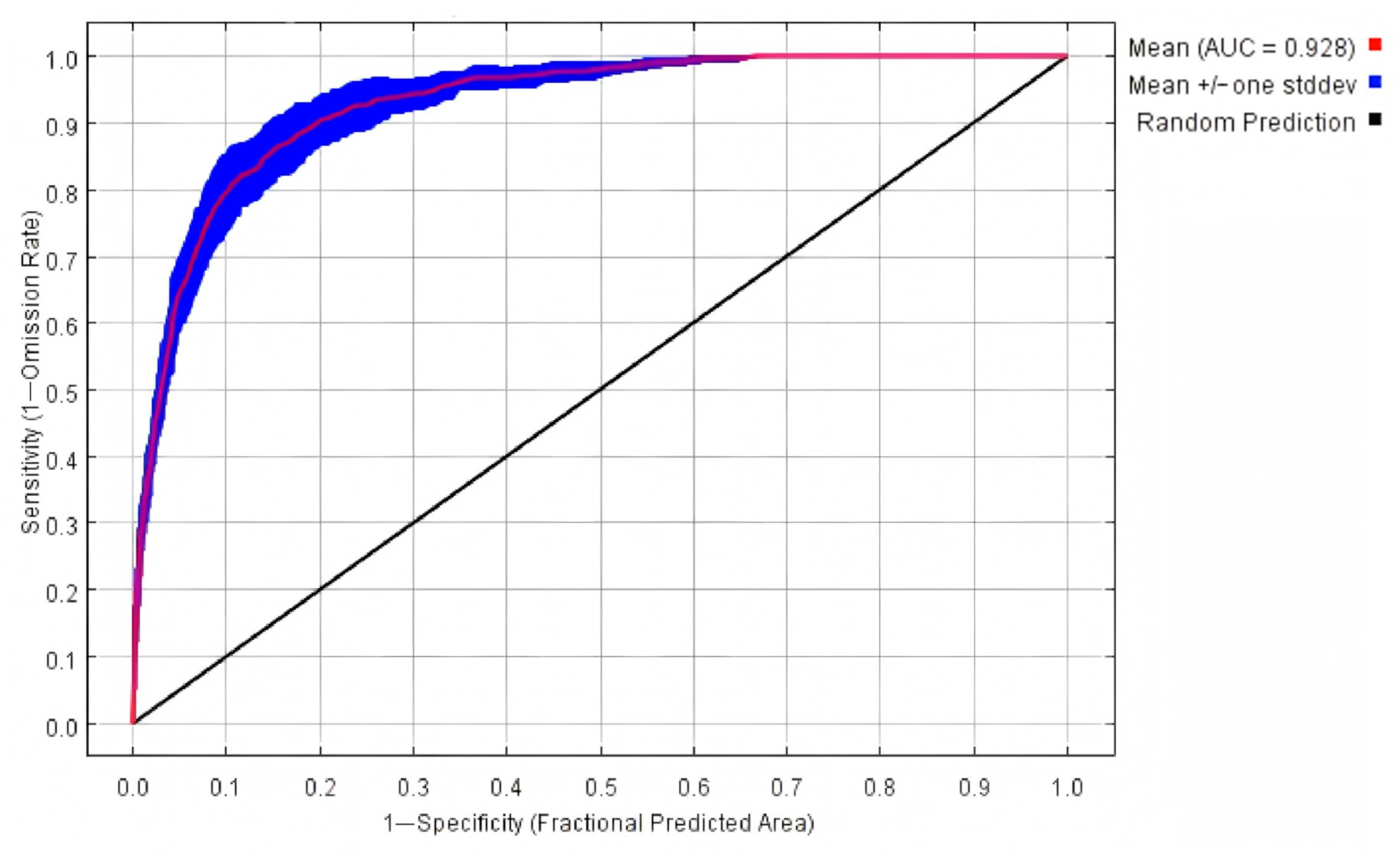
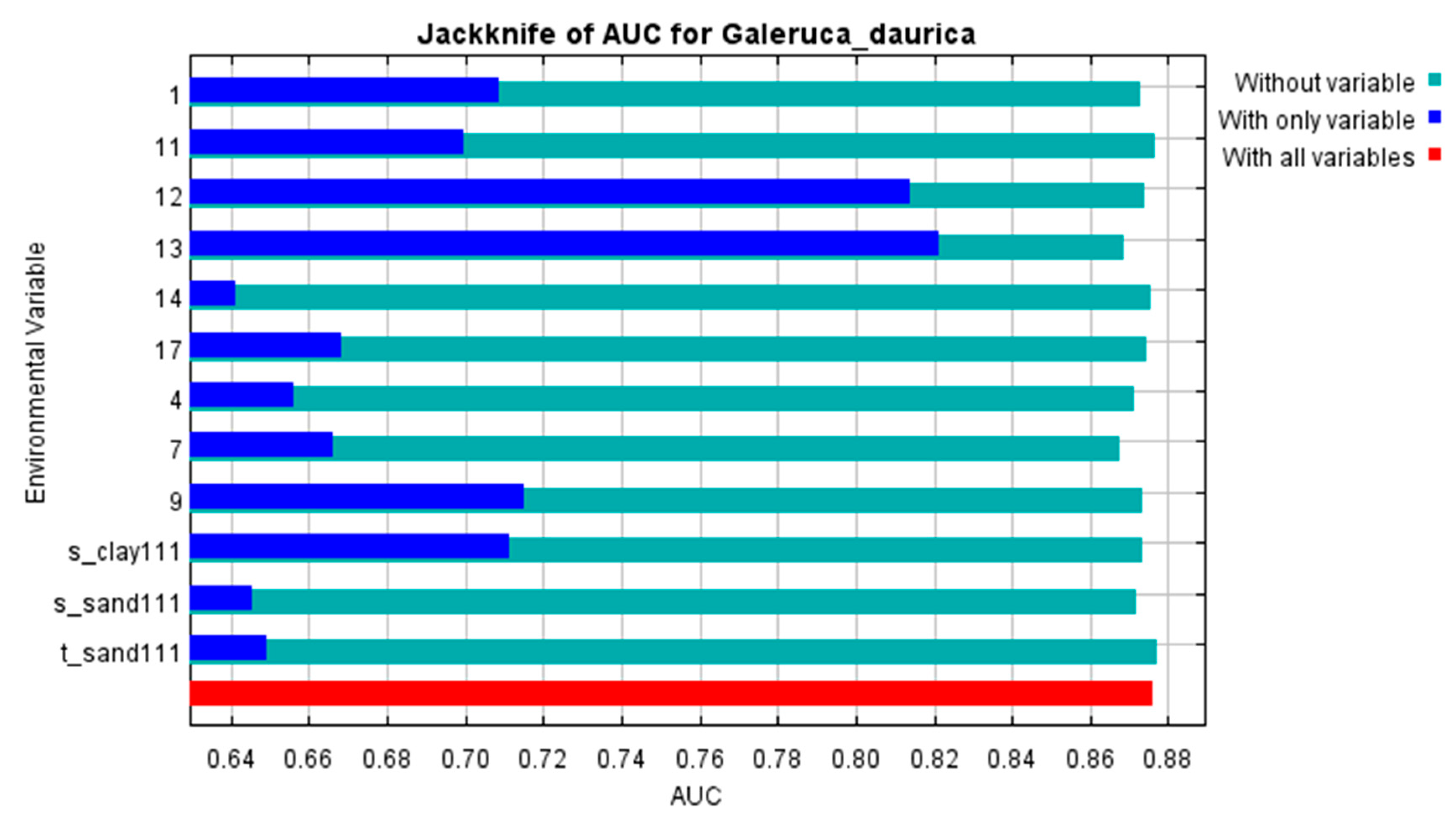
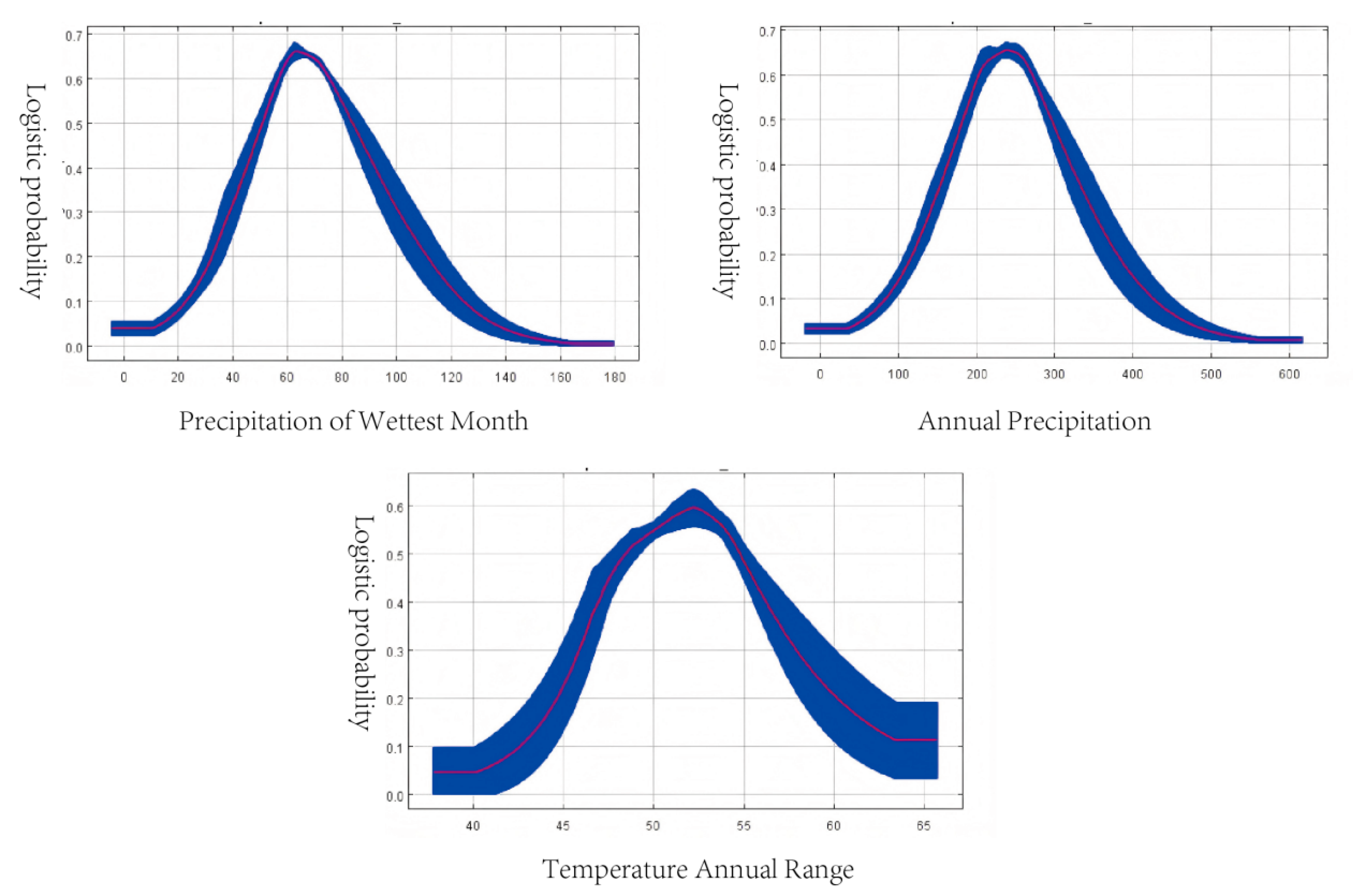

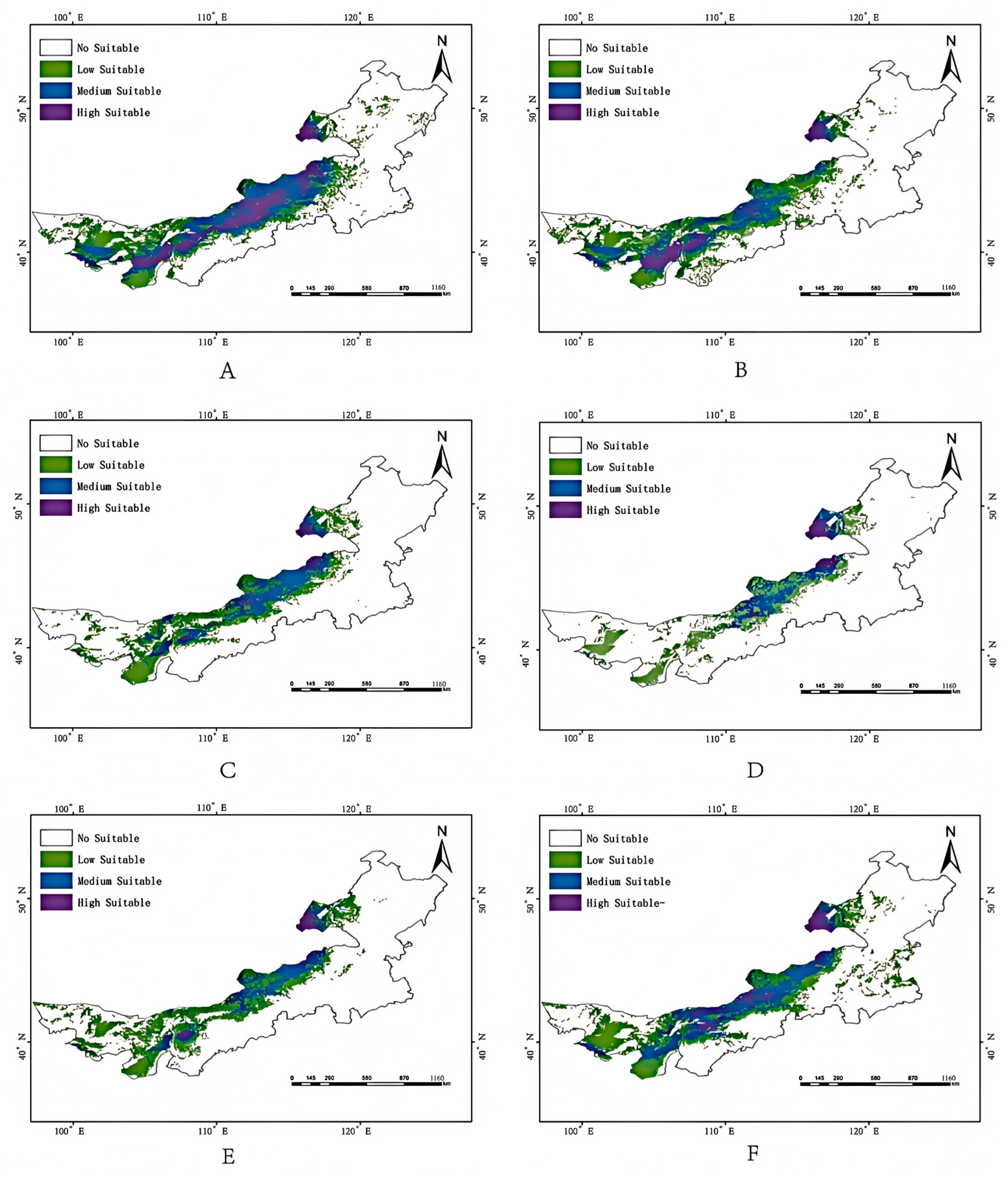
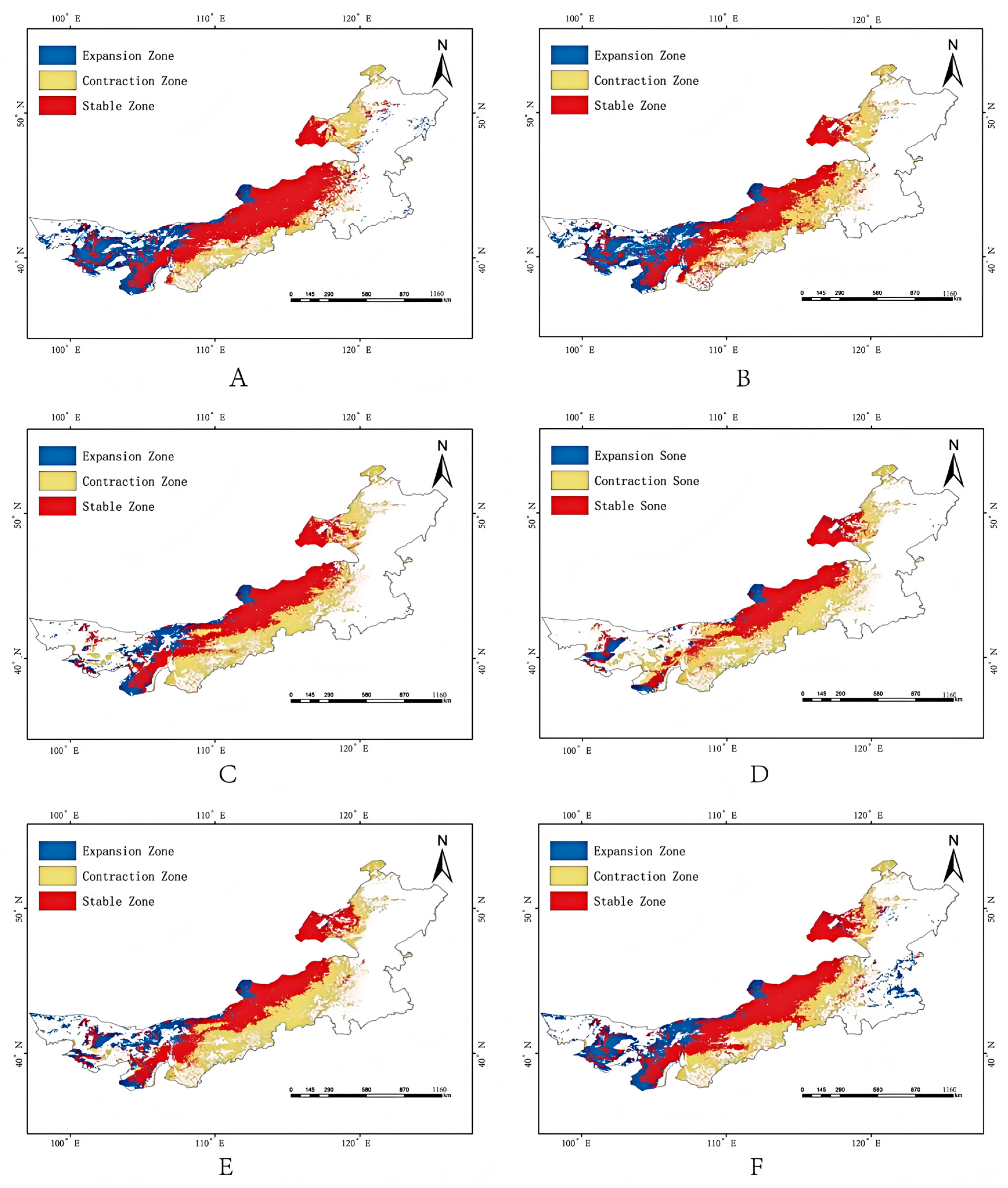
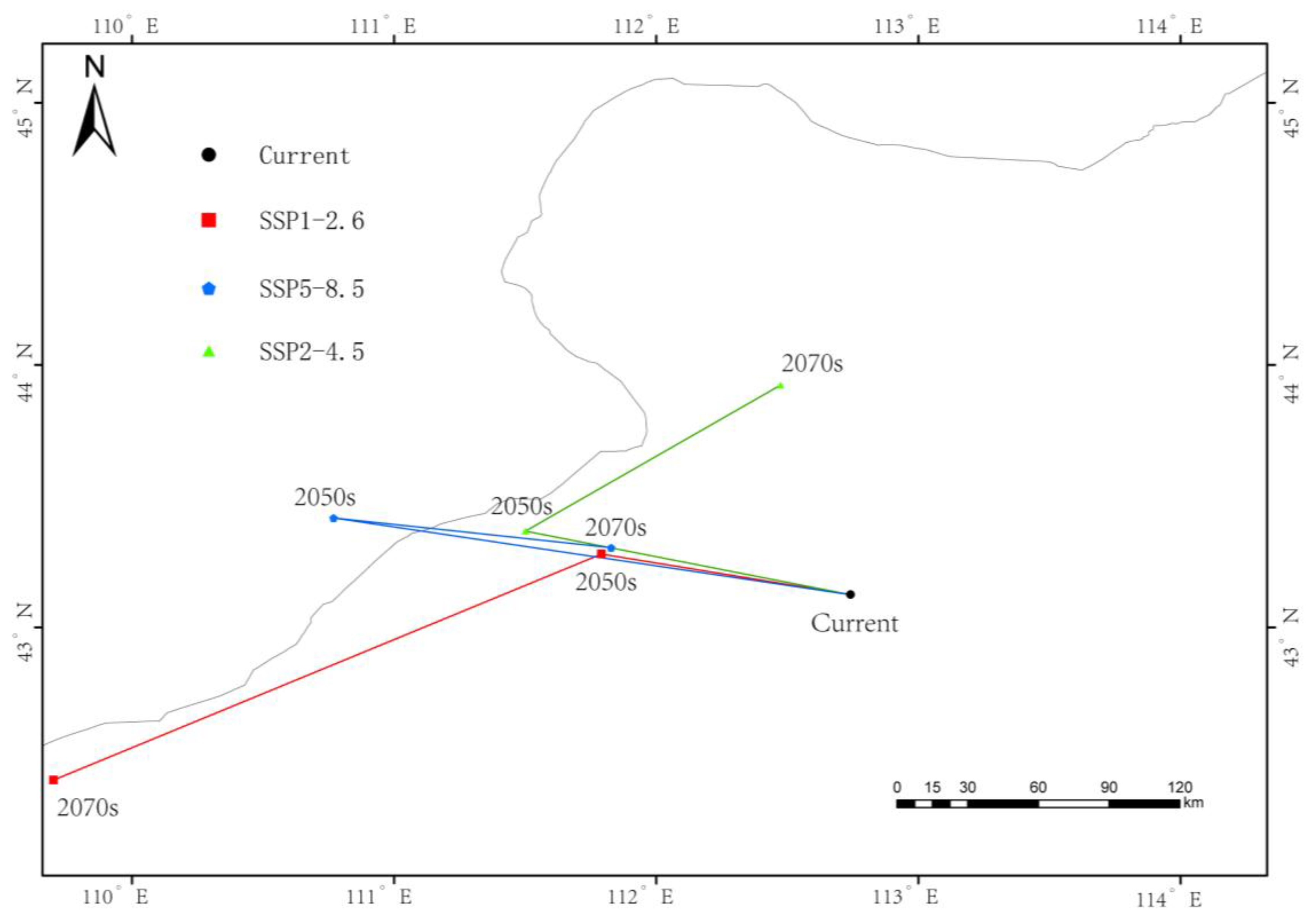
| Code | Environmental Variables | Unit |
|---|---|---|
| Bio1 | Annual Mean Temperature | °C |
| Bio4 | Temperature Seasonality | °C |
| Bio7 | Annual Temperature Range | °C |
| Bio9 | Mean Temperature of Driest Quarter | °C |
| Bio11 | Mean Temperature of Coldest Quarter | °C |
| Bio12 | Annual Precipitation | mm |
| Bio13 | Precipitation of Wettest Month | mm |
| Bio14 | Precipitation of Driest Month | mm |
| Bio17 | Precipitation of Driest Quarter | mm |
| s_sand | Subsoil Sand Content | % weight |
| s_clay | Subsoil Clay Content | % weight |
| t_sand | Topsoil Sand Content | % weight |
| Current | 2050s | 2070s | |||||
|---|---|---|---|---|---|---|---|
| Climate Scenario | — | SSP1-2.6 | SSP2-4.5 | SSP5-8.5 | SSP1-2.6 | SSP2-4.5 | SSP5-8.5 |
| AUC | 0.928 | 0.924 | 0.928 | 0.930 | 0.933 | 0.923 | 0.921 |
| Circumstances | Low Suitable | Medium Suitable | High Suitable | All |
|---|---|---|---|---|
| Current | 26.45 | 14.92 | 11.76 | 53.13 |
| 2050-126 | 21.05 | 16.41 | 14.35 | 51.81 |
| 2050-245 | 20.61 | 11.65 | 3.59 | 35.85 |
| 2050-580 | 23.12 | 9.17 | 3.3 | 35.59 |
| 2070-126 | 25.36 | 13.26 | 6.91 | 45.53 |
| 2070-245 | 17.67 | 6.99 | 3.17 | 27.83 |
| 2070-585 | 24.31 | 15.35 | 6.84 | 46.5 |
| Stage | Longitude | Latitude | Migration Distance (km) |
|---|---|---|---|
| SSP1-2.6-2050s | 111.7907 | 43.2791 | 183.64 |
| SSP1-2.6-2070s | 109.7002 | 42.4163 | 27.27 |
| SSP2-4.5-2050s | 111.5007 | 43.3661 | 112.73 |
| SSP2-4.5-2070s | 112.4735 | 43.9228 | 47.27 |
| SSP5-8.5-2050s | 110.7691 | 43.4158 | 122.73 |
| SSP5-8.5-2070s | 111.8278 | 43.3025 | 121.82 |
Disclaimer/Publisher’s Note: The statements, opinions and data contained in all publications are solely those of the individual author(s) and contributor(s) and not of MDPI and/or the editor(s). MDPI and/or the editor(s) disclaim responsibility for any injury to people or property resulting from any ideas, methods, instructions or products referred to in the content. |
© 2025 by the authors. Licensee MDPI, Basel, Switzerland. This article is an open access article distributed under the terms and conditions of the Creative Commons Attribution (CC BY) license (https://creativecommons.org/licenses/by/4.0/).
Share and Cite
Xu, T.-Y.; Bai, X.-S.; Ren, M. Predicting the Potential Distribution of Galeruca daurica in Inner Mongolia Under Current and Future Climate Scenarios Using the MaxEnt Model. Biology 2025, 14, 1477. https://doi.org/10.3390/biology14111477
Xu T-Y, Bai X-S, Ren M. Predicting the Potential Distribution of Galeruca daurica in Inner Mongolia Under Current and Future Climate Scenarios Using the MaxEnt Model. Biology. 2025; 14(11):1477. https://doi.org/10.3390/biology14111477
Chicago/Turabian StyleXu, Tian-Yu, Xiao-Shuan Bai, and MU Ren. 2025. "Predicting the Potential Distribution of Galeruca daurica in Inner Mongolia Under Current and Future Climate Scenarios Using the MaxEnt Model" Biology 14, no. 11: 1477. https://doi.org/10.3390/biology14111477
APA StyleXu, T.-Y., Bai, X.-S., & Ren, M. (2025). Predicting the Potential Distribution of Galeruca daurica in Inner Mongolia Under Current and Future Climate Scenarios Using the MaxEnt Model. Biology, 14(11), 1477. https://doi.org/10.3390/biology14111477






